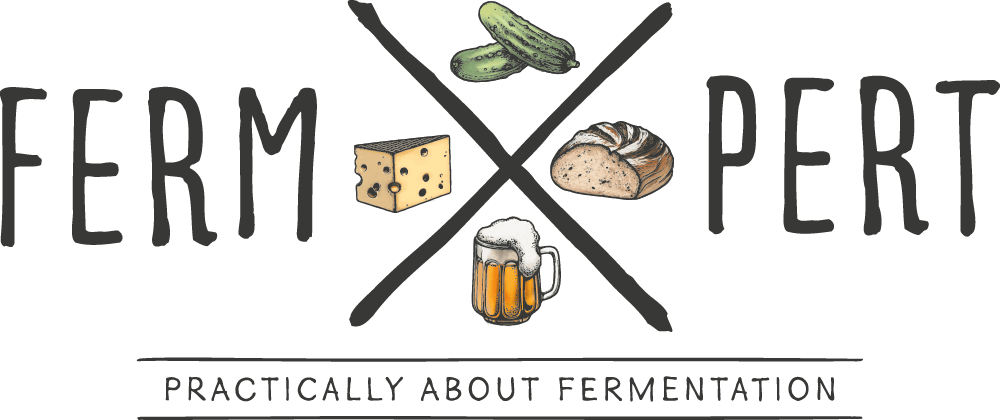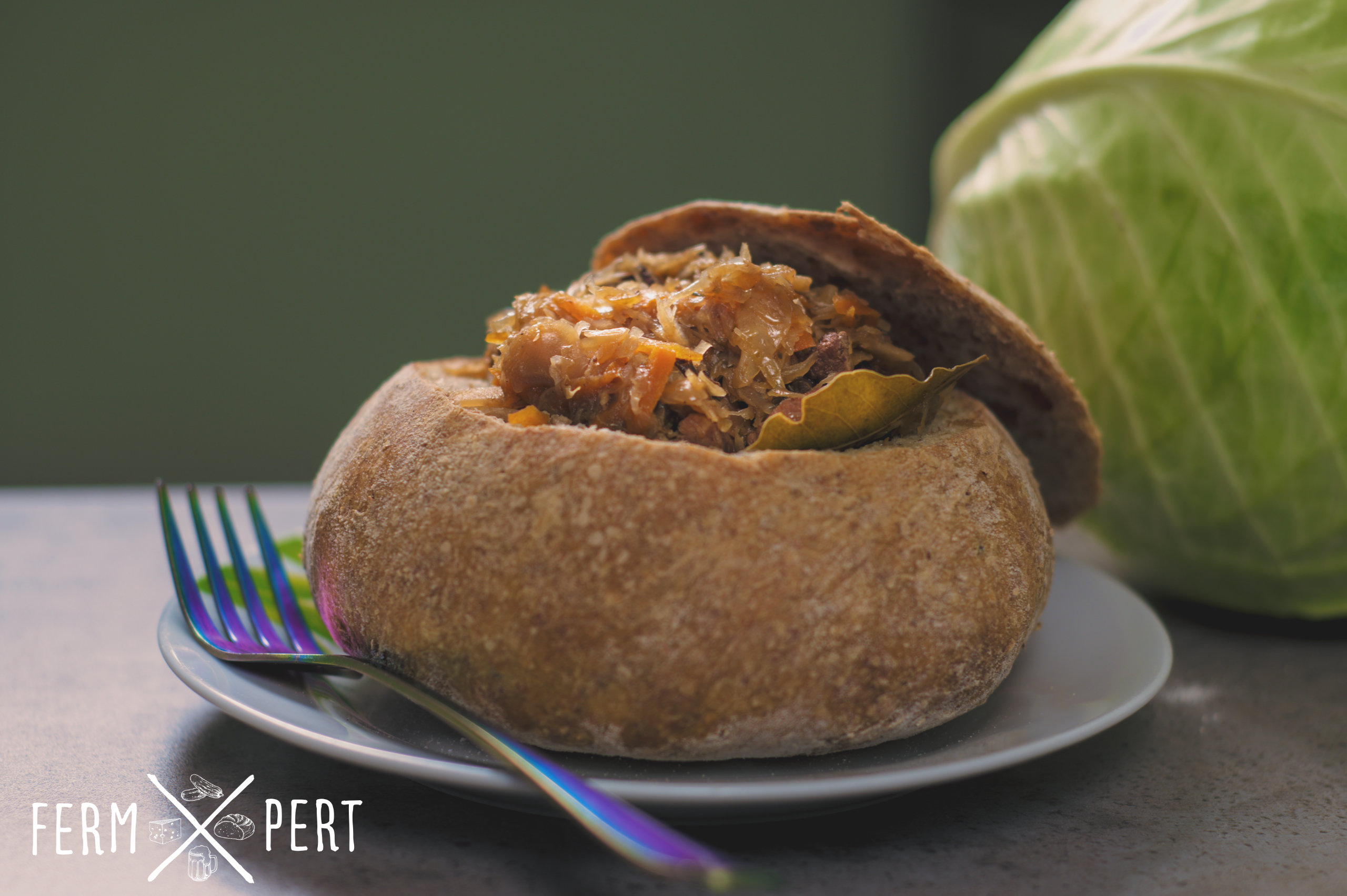Bigos is a typical Polish dish, although it’s also eaten in Luthuania and Belarus. Initially, in the XVII-XVIII century, it was a meat dish, but over time part of the ingredients were replaced with the cheaper and easily obtainable cabbage. A recipe I’m familiar with, dating back to the very beginning of the XX century, already contains the same ingredients and in the same ratios as modern ones. And how do I make it?
Recipe
- 1 kg lean pork (ham, loin)
- 1 kg strained sauerkraut
- two medium sized onions
- half a litre of strong broth
- half a cup tomato puree (or a spoonful of tomato paste)
- 1 cup red dry wine
- handful of dries bay boletes
- handful of prunes
- 3 bay leaves
- a few allspice seeds
- 1 tbsp dried marjoram
- fat for frying
- salt and pepper to taste
Cover the mushrooms with boiling water and let them soak, then thinly slice. Keep the water they’re soaking in. Chop the onions. Slice the prunes. Give the sauerkraut a very rough chop. If it’s overly sour, rinse it with running water or replace part of it with sliced fresh cabbage. Roughly dice the meat and sear. Deglaze the pan using the onions, fry until translucent.
Place all of the ingredients, including the water the mushroom have been soaking in, in a large pot. Mix, add salt and pepper, top with water if needed to prevent dry ingredients sticking out on top. Simmer gently for a few hours, stirring occasionally. The simmering is done when sauerkraut becomes completely soft.
Let it rest for at least a day, then serve reheated.
Additional Information
Traditionally, bigos is made with a few kinds of meat. Sometimes it’s even said that the more the meat variety, the better the dish. Kiełbasa (Polish smoked sausage), bacon, pork, beef, sometimes even game are on the ingredient list of many a recipe, though the meat to sauerkraut ratio is always 1:1 by mass. This means that for every kilo of kraut, a kilo of meat is used. This becomes a problem when too many kinds of meat are used: each one is used in small quantites. On the other hand, if leftover bits and pieces are available, they can be used to enrich the bigos.
Most of the ingredients in my recipe should be treated as optional. Meat and cabbage are the base, it’s also not advised to omit the broth. However, wine, prunes, tomato puree, even mushrooms and onions can technically be omitted. In fact, I also forego some ingredients that some recipes call for. It’s not uncommon to thicken the bigos with flour (usually in the form of roux). Caraway is sometimes used, as are various herbs. Sometimes prunes are substituted by apples or powidl (unsweetened prune jam). The sweetness can also be bumped with the addition of honey.
It’s a good idea to make a larger batch of bigos. I usually triple the amounts in the above recipe. Bigos stores well in the freezer or in jars, pasteurised. In order to guarantee a very long shelf life, measured in years, it’s a good idea to tyndallise the jars (pasteurise three times in one day intervals).
Video Transcription
Bigos, also known as hunter’s stew, is often considered the national Polish dish. It’s filling, delicious, sweet and sour, and it’s made from basic ingredients that were easy to obtain in Poland in the XIX century. Nowadays, it has a few regional varieties, which I mention, alongside the recipe with ingredient amounts, on the blog.
Bigos does not have a single fixed recipe. Certain ingredients are optional and every household has its own way of preparing the dish. I will share mine, which I consider a relatively simple one. Do you make it at home? Share your recipe in the comments!
Sauerkraut is one of my base ingredients. I don’t use fresh cabbage. There’s also as much meat as there’s sauerkraut. I use pork loin here, though usually I go for ham. Dried mushrooms are a must. Bay boletes in my case. There’s also some broth, a bit of tomato puree, onions, red wine, prunes, bay leaves, allspice and marjoram. I will also need salt and black pepper. I’ll use a mix of lard and rendered smoked bacon fat for frying.
I start by rehydrating the mushrooms with hot water. This will make them easier to slice.
The onions will provide some sweetness. I like to finely chop them.
I slice the prunes. I think they add a bit of richness to the stew. Mine are plain, but I’d use smoked prunes if I had them at hand.
I dice the meat into less than bite sized pieces. My meat is always lean pork, usually ham, but traditional recipes call for kielbasa, or Polish sausage, as well as several other types of meat, some of them smoked. Game is also often called for, which makes sense. This is hunter’s stew, after all. Still, I find that just a single type of pork is sufficient.
Sauerkraut goes next. I’ve squeezed the brine from it, so it’s rather dry and doesn’t splash. It’s enough to roughly slice the pile, vertically and horizontally. This is just to prevent too many long strands of cabbage in the stew.
The mushrooms are now rehydrated. They’re still hot, but I manage to slice them without getting my hands burned. I preserve the water used to rehydrate them too. It’s chock full of flavour.
That’s it for ingredient preparation. Time to place them in a large pot. Homemade broth goes in first. Any type will do. I happen to have chicken broth. I also add red dry wine. It’s an optional ingredient. Then, homemade tomato puree. Most recipes call for a much smaller amount of tomato paste, but in the end, it’s the same ingredient. Prunes go in. Bay leaves and allspice. Marjoram. Mushrooms, along with the water they were soaking in. And finally, sauerkraut.
I need to sear the meat first. I heat a frying pan up and add some rendered bacon fat and some lard. I fry the meat one handful at a time. A larger portion of meat would lower the pan’s temperature too much and could lead to it releasing moisture and stewing instead of frying. What I aim at is browning the meat, without burning it. This process is known as non-enzymatic browning or Maillard reaction.
Lastly, I fry the onions. I will use them to deglaze the pan, or, in other words, collect the caramelised bits left after frying the meat. They contain a lot of flavour and I don’t want to lose any. I’m done once the onions are translucent and looking like this.
My pot is almost ready to begin the stewing process. I add water to make sure there are no dry ingredients on top. Mixing is a bit of a chore, so I switch to a slightly firmer utensil. Which still isn’t ideal, but I don’t have a better one. This is a non-stick pot, so I can’t use metal on it. A wooden spoon would have worked great, but I don’t have one.
I give everything a mix and finally add a good amount of freshly ground black pepper and salt. I will now leave the pot to very gently simmer, stirring occasionally to prevent scorching. I’ll be done when the sauerkraut has gone completely soft. This takes several hours, usually around three.
I’m more comfortable with cooking on my gas stove, so I finished the stewing there. I also tasted my bigos and adjusted the salt. This is what it looks like once the simmering is done. It’s far from ready, but I’ll have a quick taste. Mmm, so good!
Bigos tastes best once it’s had at least a day’s rest, so I’ll leave it on the stovetop to cool down and then transfer it to the fridge.
On the next day, I heat up a portion. But I’m not going to eat it just like that. The usual way would be to serve it with mashed potatoes or with a few slices of bread, but there’s a better way. I’ve just baked two small loaves of bread. They’re still a bit warm. I’ll serve my bigos inside.
I first cut off the top from the loaf. Then I gently run the knife along the inside to scoop out most of the crumb from it. Oh, this bread is good! I put bigos inside the loaf. There, that’s how I serve it! Alright, time to give it a taste. This is an unbelievable dish. Sour, with a hint of sweetness and a ton of umami from the broth, the meat and the mushrooms. Perfection!

